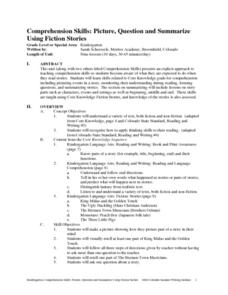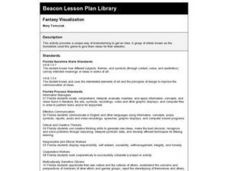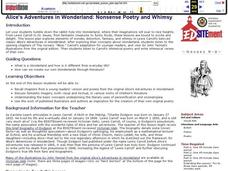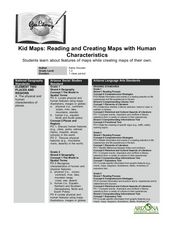Curated OER
Comparing or Contrasting Two Books
Students compare two pieces of literature. In this literary comparisons lesson, students read 2 books that they personally select and then compare and contrast the literary elements of each in a comparative essay.
Curated OER
Telling A Story
Students discover that every story has a start, middle and end. In this literature lesson, the teacher models using a picture to show the parts of the story. Students each take a picture and tell a story using start, middle and end.
Curated OER
Diary of Anne Frank: Act 1 Scene 1 & 2
Eighth graders read act 1 scenes 1 & 2 of the play Diary of Anne Frank. In this Diary of Anne Frank lesson plan, 8th graders discuss how the setting of the play affects the mood of the story and answer short answer questions.
Curated OER
The Mysteries of Harris Burdick
Fourth graders read and discuss the book, The Mysteries of Harris Burdick. They create an original story that follows the Harris Burdick formula, and illustrate the story in the style of Chris VanAllsberg.
Curated OER
Comprehension Skills: Picture, Question and Summarize Using Fiction Stories
Students build a variety of comprehension skills through the nine lessons of this unit. Picturing events, monitoring understanding during reading, forming questions, and summarizing stories form the core of the lessons being taught in...
Curated OER
Fantasy Visualization
Young scholars view and discuss a selection of paintings from Salvador Dali, Rene Magritte, and other Surrealist artists. They play a game in which each person in a group writes a sentence and passes it on to the next person without...
McGraw Hill
Study Guide for Tuck Everlasting
Tuck Everlasting by Natalie Babbitt is a classic novel that readers have enjoyed for years. Resources within the study guide such as discussion and guided reading questions, extension activities, and graphic organizers aid comprehension...
Curated OER
Bridging the Centuries: Teaching the Nineteenth Century English Novel Today
Students compare and contrast the elements used in the 19th century British novel and those novels in American society today. In groups, they brainstorm what it might have been like to be a teenager growing up in England during the 19th...
Curated OER
Integrating Anime and Manga into an Art of Motion Picture Course
Students examine the art of Anime and note its characteristics. Using scenes, they identify the plots, characters and themes trying to be portrayed. In groups, they compare and contrast the animation in America to that of Anime and...
Curated OER
Completing a Christmas Story
Students discuss with teacher how to complete a short story and the elements necessary: characters, settings, themes, and plots. They then use the worksheet to complete the short story.
Curated OER
"The Fog Horn" by Ray Bradbury
Students read Ray Bradbury's "The Fog Horn" and complete reading and vocabulary activities. In this reading and vocabulary lesson plan, students review the vocabulary for the story and take turns reading the story. Students discuss the...
Curated OER
Science Fiction Lesson Plans
Students can explore a literature genre through science fiction lesson plans.
Curated OER
Writing Myths
Learners read and write myths. In this world mythology activity, students read and analyze myths from various cultures and then recognize their attributes as they write their own myths that explain natural phenomena.
Curated OER
Headless Horseman, Heady Author
Twelfth graders explore figurative language as it appears in Washington Irving's original text, The Legend of Sleepy Hollow, answer questions based on story, and write sequels to it by using the different types of figurative language...
Curated OER
Frankenstein
Share a classic novel with your class using this resource. After reading Frankenstein by Mary Shelley, learners answer questions involving the narrator's point of view, make and confirm predictions, and sequence events in the story.
Curated OER
Alice's Adventures in Wonderland: Nonsense Poetry and Whimsy
Primary learners are introduced to Lewis Carroll's whimsical poetry. They read "The Nursery Alice" Carroll's adaptation for younger readers, view story illustrations, listen to poetry and write whimsical verses of their own about food.
Curated OER
Pebbles, Sand and Silt -- Categorizing Fiction and Informational Books
Primary readers complete the activities in a Pebbles, Sand and Silt FOSS kit. As a class, they are given a group of rocks and they are to categorize them based on their activities in the FOSS kit. They use this information and apply it...
Curated OER
Oh, Let the Rain Fall Down
Fifth graders explain the three phases of the water cycle in a narraive paragraph where they describe the journey of a single raindrop. They are introduced to five science vocabulary words and personfication.
Curated OER
Creature Feature
Students work in pairs to create a creature and its habitat out of construction paper. Then students write a narrative to describe the animal and its habitat.
Curated OER
Alice's Adventures in Wonderland and Through the Looking-Glass Questions
In this reading comprehension worksheet, students respond to 9 short answer and essay questions based on Lewis Carroll's Alice’s Adventures Through the Looking Glass.
Curated OER
Kid Maps: Reading and Creating Maps with Human Characteristics
Learners look at maps. In this map instructional activity, students listen to the book My Map Book by Sara Fanelli and they see the difference between human characteristics (buildings, etc.) and natural characteristics (rivers, etc.)....
Curated OER
ESL Poetry Unit
Students complete a twelve lesson unit on poetry. They read and respond to different forms of poetry, write a bio poem, complete an online WebQuest, and in small groups present lessons to the class on various types of poems.
Curated OER
Coyote and Anansi
Students explore the structure of folktales. In this coyote and Anansi lesson, students discuss the attributes of folktales as they read versions of tales featuring coyote and Anansi. Students collaborate to write and perform their own...
Curated OER
Wolves
Students utilize several different sources to research wolves, after completing the K-W-L process.

























